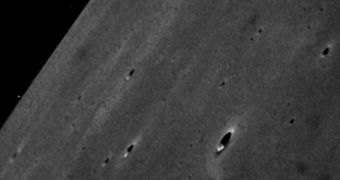The NASA Lunar Atmosphere and Dust Environment Explorer (LADEE) spacecraft has successfully concluded its mission around the Moon, mission controllers at the agency's Ames Research Center (ARC) in Moffett Field, California, announce today, April 18. The probe dropped in altitude and impacted the surface of the Moon yesterday evening.
According to the mission team, the impact was confirmed to have occurred sometime between 9:30 pm and 10:22 pm EDT (0300 to 0222 GMT today), on Thursday, April 17. This end was planned for the mission, as NASA wanted to extend LADEE's operational life by as much as possible. Originally, its mission was supposed to last for 100 days, but another month of operations was later added.
The reason why the probe was intentionally crashed into the lunar surface is that it no longer had the necessary fuel to maintain its orbit around Earth's natural satellite. Science operations therefore became impossible, and NASA officials wanted to control the approximate spot where the spacecraft would land. They set it on a decaying orbit after concluding the low-altitude science phase of the mission.
ARC engineers believe that the spacecraft broke apart upon impact, with several of its components heating up to hundreds of degrees in the process. What pieces endured the impact are now buried in shallow craters on the lunar surface. Intact, the probe was around the size of a regular vending machine.
“At the time of impact, LADEE was traveling at a speed of 3,600 miles [5,800 kilometers] per hour – about three times the speed of a high-powered rifle bullet,” says ARC LADEE project scientist Rick Elphic. He adds that maneuvers to lower the probe's orbit were conducted in early April.
“There’s nothing gentle about impact at these speeds – it’s just a question of whether LADEE made a localized craterlet on a hillside or scattered debris across a flat area. It will be interesting to see what kind of feature LADEE has created,” the expert goes on to say.
Following the orbital correction maneuvers earlier this month, LADEE was flying less than two kilometers (one mile) above the lunar surface. This enabled the science team to collect a wealth of unique data, since no other probe has collected this type of readings before.
After surviving the total lunar eclipse on April 14 to 15, the spacecraft was set on a trajectory that allowed for an impact on the far side of the Moon, away from any previous mission objectives, including the Apollo landing sites. The area where the probe impacted the surface cannot be viewed directly from Earth.
“It's bittersweet knowing we have received the final transmission from the LADEE spacecraft after spending years building it in-house at Ames, and then being in constant contact as it circled the moon for the last several months,” concluded Butler Hine, who managed the LADEE project at ARC.

 14 DAY TRIAL //
14 DAY TRIAL //